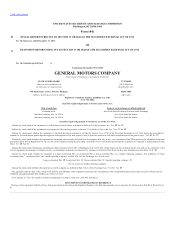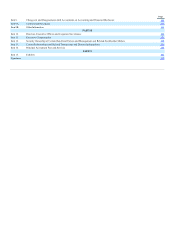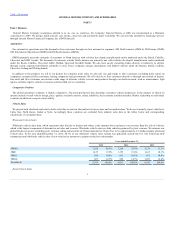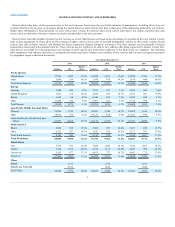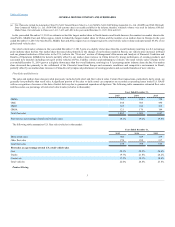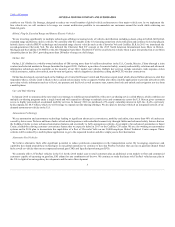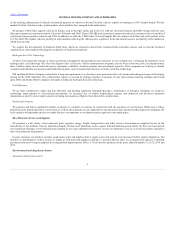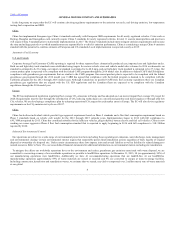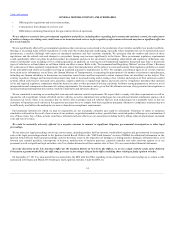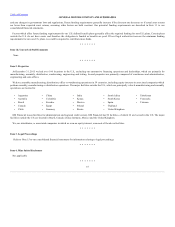General Motors 2015 Annual Report Download - page 11
Download and view the complete annual report
Please find page 11 of the 2015 General Motors annual report below. You can navigate through the pages in the report by either clicking on the pages listed below, or by using the keyword search tool below to find specific information within the annual report.
Table of Contents
In the long-term, we expect that the EC will continue devising regulatory requirements on the emission test cycle, real driving emission, low temperature
testing, fuel evaporation and OBD.
China
China has implemented European type China 4 standards nationally with European OBD requirements for all newly registered vehicles. Cities such as
Beijing, Shanghai and Guangzhou each currently require China 5 standards for newly registered vehicles. In total 11 eastern municipalities and provinces
will require China 5 standards prior to nationwide implementation in 2017. The China 5 standards include more stringent emission requirements and increase
the time and mileage periods over which manufacturers are responsible for a vehicle's emission performance. China is considering a unique China 6 emission
standard with the potential to combine elements of European and U.S. standards. Local implementation is expected as early as 2019.
Automotive Fuel Economy
U.S. and Canada
Corporate Average Fuel Economy (CAFE) reporting is required for three separate fleets: domestically produced cars, imported cars and light-duty trucks.
Both car and light-duty truck standards were established using targets for various vehicle sizes and vehicle model sales volumes. In 2016 our domestic car
standard is estimated to be 36.2 mpg, our import car standard is estimated to be 40.0 mpg, and our light-duty truck standard is estimated to be 27.1 mpg. Our
current product plan is expected to be compliant with the federal CAFE program through the 2016 model year. In addition to federal CAFE the EPA requires
compliance with greenhouse gas requirements that are similar to the CAFE program. Our current product plan is expected to be compliant with the federal
greenhouse gas program through the 2016 model year. CARB has agreed that compliance with the federal program is deemed to be compliant with the
California program for the 2012 through 2016 model years. Although Canada has no parallel CAFE-style fuel economy regulations there are Canadian
greenhouse gas regulations that are aligned with the U.S. EPA regulations and the Canadian fleets are expected to be compliant with the Canadian
regulations through the 2016 model year.
Europe
The EU has implemented legislation regulating fleet average CO2 emissions in Europe and has adopted an even more stringent fleet average CO2 target for
2020. Requirements must be met through the introduction of CO2 reducing technologies on conventional gasoline and diesel engines or through ultra-low
CO2 vehicles. We are developing a compliance plan by adopting operational CO2 targets for each market entry in Europe. The EC will also devise regulatory
requirements on the CO2 emission test cycle as of 2017.
China
China has both an individual vehicle pass-fail type approval requirement based on Phase 2 standards and a fleet fuel consumption requirement based on
Phase 3 standards based on vehicle curb weight for the 2012 through 2015 calendar years. Implementation began in 2012 with full compliance to
6.9L/100km required by 2015. China has continued subsidies for fuel efficient vehicles, plug-in hybrid, battery electric and fuel cell vehicles. China is now
working on a more aggressive Phase 4 fleet fuel consumption standard that is expected to apply beginning in 2016 with full compliance to 5.0L/100km
required by 2020.
Industrial Environmental Control
Our operations are subject to a wide range of environmental protection laws including those regulating air emissions, water discharge, waste management
and environmental cleanup. Certain environmental statutes require that responsible parties fund remediation actions regardless of fault, legality of original
disposal or ownership of a disposal site. Under certain circumstances these laws impose joint and several liability as well as liability for related damages to
natural resources. Refer to Note 15 to our consolidated financial statements for additional information on environmental matters including site remediation.
To mitigate the effects our worldwide operations have on the environment and reduce greenhouse gas emissions associated with waste disposal, we are
committed to converting as many of our worldwide operations as possible to landfill-free operations. At December 31, 2015, 90 (or approximately 50%) of
our manufacturing operations were landfill-free. Additionally we have 41 non-manufacturing operations that are landfill-free. At our landfill-free
manufacturing operations approximately 89% of waste materials are reused or recycled and 9% are converted to energy at waste-to-energy facilities.
Including construction, demolition and remediation wastes, we estimate that we reused, recycled or composted over 2 million metric tons of waste materials
at our global
8

